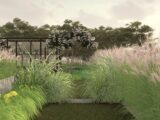The African Fern Pine (Afrocarpus gracilior), also known as Podocarpus gracilior or Fern Pine, is an elegant evergreen tree that brings a touch of sophistication to any landscape.
Native to East Africa, this versatile plant is prized for its graceful, fern-like foliage, and its adaptability to various growing conditions. Whether you want to use it as a hedge, screen, or standalone specimen, the African Fern Pine is an excellent choice for both residential and commercial landscapes. This comprehensive guide will provide you with all the information you need to successfully grow and care for African Fern Pine.
Introduction to African Fern Pine

Characteristics
- Scientific Name: Afrocarpus gracilior (syn. Podocarpus gracilior)
- Common Names: African Fern Pine, Fern Pine, Weeping Podocarpus
- Family: Podocarpaceae
- Origin: East Africa (Kenya, Ethiopia, and Uganda)
- Height: 20-60 feet
- Width: 15-25 feet
- Hardiness Zones: USDA zones 9-11
- Growth Rate: Moderate to fast
- Foliage: Evergreen, dark green, fern-like leaves
- Flowers: Inconspicuous
- Fruit: Small, fleshy, blue-black seeds
Why Grow African Fern Pine?
- Ornamental Appeal: Attractive foliage and elegant form.
- Versatility: Suitable for hedges, screens, or as a standalone tree.
- Low Maintenance: Once established, it requires minimal care.
- Drought Tolerant: Can withstand periods of drought, making it ideal for water-wise gardens.
Planting African Fern Pine
The success of growing African Fern Pine starts with proper planting. Here’s how to ensure your Fern Pines get off to a great start.
When to Plant
The best time to plant African Fern Pine is in spring or fall when temperatures are moderate. This allows the tree to establish roots before the stress of extreme summer heat or winter cold.
Site Selection
African Fern Pine thrives in full sun to partial shade. Choose a site that receives at least 4-6 hours of sunlight daily. While it prefers well-drained soil, it can tolerate a range of soil types, including sandy and clay soils.
Soil Preparation
Ensure the soil is well-draining and rich in organic matter. You can amend the planting site with compost or well-rotted manure to improve soil fertility and drainage.
Planting Steps
- Dig the Hole: Dig a hole twice as wide and as deep as the root ball.
- Prepare the Plant: Remove the plant from its container and gently tease out the roots.
- Place the Plant: Position the Fern Pine in the hole so that the top of the root ball is level with the soil surface.
- Backfill: Fill the hole with the excavated soil, firming it gently around the roots.
- Watering: Water thoroughly to settle the soil and eliminate air pockets.
- Mulching: Apply a 2-3 inch layer of mulch around the base of the plant to retain moisture and suppress weeds.
Caring for African Fern Pine
Once your African Fern Pine is planted, proper care will ensure it remains healthy and vibrant. Here are the key aspects of Fern Pine care:
Watering
During the first growing season, water regularly to establish a deep, extensive root system. Once established, African Fern Pines are fairly drought-tolerant but benefit from regular watering during prolonged dry periods.
Fertilizing
African Fern Pines are not heavy feeders. In spring, apply a balanced, slow-release fertilizer or a layer of compost around the base of the plant. Avoid high-nitrogen fertilizers, as these can promote excessive foliage growth at the expense of root development.
Pruning
Pruning is essential to maintain the shape and encourage vigorous growth.
- When to Prune: The best time to prune African Fern Pine is in late winter or early spring before new growth begins.
- How to Prune: Remove any dead, damaged, or diseased branches. Thin out overcrowded branches to improve air circulation. Lightly shape the plant as desired.
Mulching
Mulching helps retain moisture, regulate soil temperature, and suppress weeds. Reapply mulch each spring and fall, keeping it a few inches away from the plant’s stems to prevent rot.
Pest and Disease Control
African Fern Pines are generally resistant to pests and diseases. However, occasional problems may arise.
- Aphids: These small insects can be controlled with insecticidal soap or a strong stream of water.
- Scale Insects: Treat with horticultural oil.
- Root Rot: Prevent by ensuring good soil drainage and avoiding overwatering.
Seasonal Care Guide
Here’s a handy seasonal guide to help you manage your African Fern Pine care throughout the year:
| Jan | Feb | Mar | Apr | May | Jun | Jul | Aug | Sep | Oct | Nov | Dec | |
|---|---|---|---|---|---|---|---|---|---|---|---|---|
| Planting | yes | yes | yes | yes | ||||||||
| Pruning | yes | yes | yes | |||||||||
| Watering | yes | yes | yes | yes | yes | yes | yes | yes | yes | yes | yes | yes |
| Fertilizing | yes |
Landscaping with African Fern Pine
African Fern Pines are versatile and can be used in various landscape settings. Here are some ideas:
Hedges and Screens
African Fern Pines make excellent hedges and screens due to their dense foliage and upright growth habit. Plant them in a row to create a natural barrier for privacy and wind protection.
Specimen Trees
Plant African Fern Pine as a standalone specimen to showcase its elegant form and graceful foliage. It can serve as a focal point in a garden or landscape design.
Mixed Borders
Combine African Fern Pines with other shrubs and perennials to create a dynamic and colorful mixed border. Their evergreen foliage provides year-round interest and structure.
Container Gardening
Dwarf varieties of African Fern Pine can be grown in containers, making them suitable for patios, decks, and balconies.
Propagating African Fern Pine
African Fern Pines can be propagated by seeds or cuttings. Here’s how:
Seed Propagation
- Collect Seeds: Harvest seeds from mature plants in late summer or early fall.
- Prepare Soil: Use a well-draining seed-starting mix.
- Sow Seeds: Plant seeds 1/4 inch deep and keep the soil moist.
- Germination: Seeds typically germinate in 4-6 weeks.
Cuttings
- Select Cuttings: In late spring or early summer, take 4-6 inch cuttings from healthy, new growth.
- Prepare Cuttings: Remove the lower leaves and dip the cut end in rooting hormone.
- Plant Cuttings: Insert cuttings into a pot filled with a well-draining mix.
- Care for Cuttings: Keep the soil moist and place the pot in a bright, indirect light. Rooting should occur in 4-6 weeks.
Dealing with Common Problems
Yellowing Leaves
Yellowing leaves can be a sign of nutrient deficiency, overwatering, or poor drainage. Check the soil moisture and adjust watering practices. A balanced fertilizer application in spring can help correct nutrient deficiencies.
Poor Growth
If your African Fern Pine is not growing well, it may be due to insufficient sunlight, poor soil, or inadequate watering. Ensure your plant receives at least 4-6 hours of sunlight daily, amend the soil if necessary, and water regularly.
Leaf Drop
Leaf drop can be caused by stress, such as transplant shock, drought, or overwatering. Ensure your plant is properly watered and mulched to retain soil moisture.
Winter Care
African Fern Pines are generally hardy but may need some protection in areas with harsh winters. Mulch around the base of the plant to insulate the roots and protect against freezing temperatures. In colder climates, consider planting African Fern Pines in sheltered locations or using frost covers during extreme cold snaps.
Popular African Fern Pine Varieties
There are several varieties of African Fern Pine, each with unique characteristics. Here are some of the most popular ones:
1. Afrocarpus gracilior (Common African Fern Pine)
- Description: The most widely grown variety, known for its elegant, fern-like foliage and upright growth habit.
- Height: 20-60 feet
- Width: 15-25 feet
2. Afrocarpus falcatus (Yellowwood)
- Description: Similar to A. gracilior but with a more spreading habit and broader leaves.
- Height: 30-70 feet
- Width: 20-30 feet
3. Podocarpus macrophyllus (Yew Pine)
- Description: A smaller, shrubbier variety with dense, dark green foliage.
- Height: 10-20 feet
- Width: 6-10 feet
Conclusion
Growing and caring for African Fern Pine can be a rewarding experience for both novice and experienced gardeners. With their stunning foliage, versatile uses, and low maintenance requirements, African
Fern Pines make a wonderful addition to any garden or landscape. By following this guide, you can enjoy the beauty and benefits of these elegant trees year-round.
Whether you’re planting them as hedges, screens, or standalone specimens, African Fern Pines are sure to enhance your landscape with their grace and resilience. Happy gardening!
This guide provides a thorough overview of how to grow and care for African Fern Pine, ensuring you have all the information needed to successfully cultivate these beautiful trees. By following the seasonal care guide and implementing the tips provided, you can enjoy the vibrant foliage and elegant form of African Fern Pine throughout the year.



